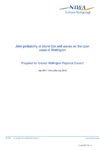Joint-probability of storm tide and waves on the coast of Wellington 2012
Search in document library
Purpose to estimate coastal inundation hazards from the combined effects of storm tide and waves for the Wellington Region.
Geographic Area: The open coast of the Greater Wellington Region, including Kapiti Coast, South Wellington, Wairarapa Coast, and Palliser Bay.
This report, prepared by NIWA for the Greater Wellington Regional Council, investigates the likelihood of coastal flooding caused by the combination of storm tides and waves along the open coast of the Wellington Region. Using hindcast data from 1957 to 2002, the study models extreme sea level and wave conditions at nine offshore sites to assess the risk of coastal inundation.
The analysis shows that the western Kapiti Coast is particularly vulnerable to events where high storm tides and large waves occur together. This is due to a strong correlation between storm tide and wave height in this area, which increases the hazard potential. In contrast, the southern and eastern coasts, including Wairarapa and Palliser Bay, experience more energetic wave climates but less correlation between storm tides and waves. This means that large waves and high sea levels tend to occur independently in these regions.
The report uses a joint-probability approach to calculate the likelihood of different combinations of storm tide and wave height occurring simultaneously. This method provides more realistic estimates of coastal hazard risk than assessing each factor separately. The analysis includes tables and contour plots showing the probability of various storm tide and wave combinations for each site, with particular attention to events with a 1% annual exceedance probability (AEP).
Wave data were calibrated using buoy measurements, particularly from Baring Head, and adjusted to account for under-prediction in the hindcast model. A scaling factor of 1.5 was applied to the largest wave events to ensure conservative estimates. Storm tide data were derived from a combination of tide, storm surge, and mean sea level, and referenced to the Wellington Vertical Datum 1953.
The report emphasizes that the results are valid for deep-water locations and do not include nearshore effects such as wave setup and run-up. These would require additional modelling using detailed coastal topography. Climate change impacts, including sea-level rise, are also not included in the current analysis.
Overall, the study provides a comprehensive assessment of coastal hazard risk from storm tides and waves in the Wellington Region. It offers valuable data for planning and infrastructure design, helping to ensure that coastal developments are resilient to extreme sea level events.
